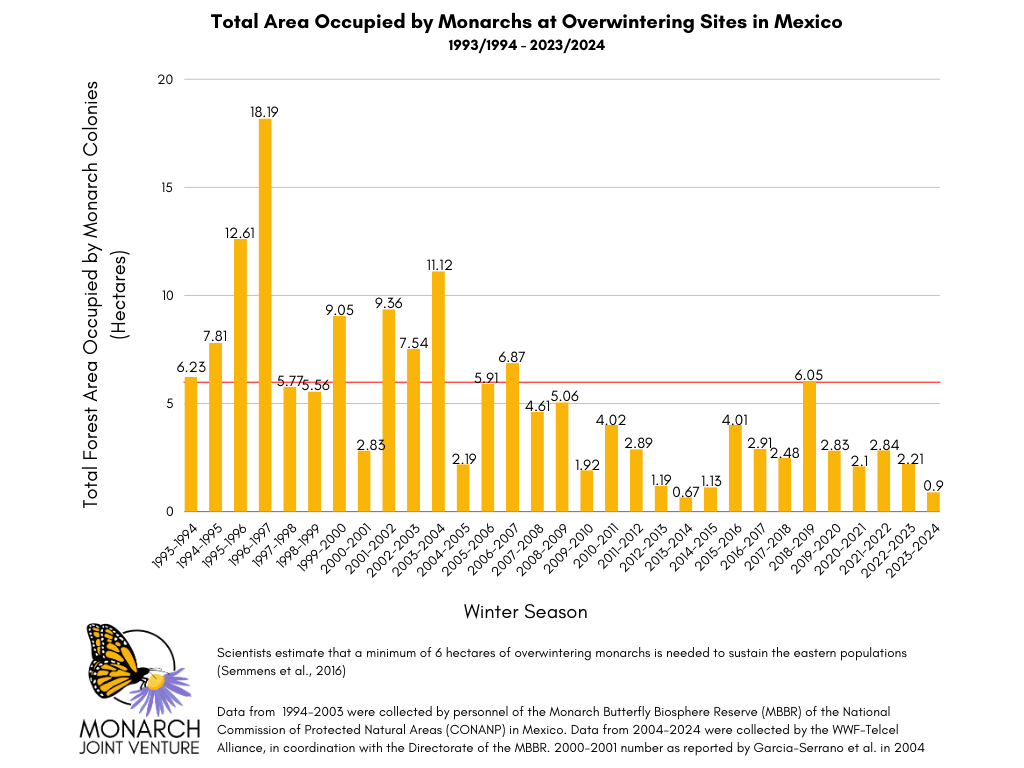
Media Contact: Wendy Caldwell, wcaldwell@monarchjointventure.org
St. Paul, Minnesota, February 7, 2024- The presence of the eastern monarch butterfly population in Mexico’s oyamel fir forests this past winter was 59.3% less than the previous year, according to the most recent survey released by the World Wildlife Fund (WWF) Mexico. Monarch butterflies occupied 0.9 hectares, 1.31 less than the 2.21 hectares in the 2022-2023 overwintering season. This is the first time since the 2013-2014 overwintering season that the eastern monarch population has occupied less than one hectare.

The eastern monarch population is surveyed each winter starting in December when monarchs are clustered together. Counting individual monarchs in these sites is too challenging, so researchers estimate the population by measuring the area they occupy (in hectares). Each hectare is approximately 2.47 acres, with the number of monarchs per hectare variable, but likely between 20-30 million monarchs per hectare (median 21.1, according to Thogmartin et al., 2017). Semmens et al., 2016 recommended a threshold of at least 6 hectares of overwintering monarchs to sustain a resilient eastern population and its migration. The current population size remains lower than the target of 6 hectares, driving continued concern for the migration and necessitating increased conservation action.
Monarch butterflies face many threats, but we can support their recovery through widespread, collaborative, and ongoing conservation action. Supporting and sustaining the monarch migration requires an organized effort across all land use sectors in North America. The Monarch Joint Venture (MJV) supports monarch and pollinator conservation planning and implementation efforts on a broad scale by facilitating information sharing, collaboration, and carrying out identified conservation priorities within its Monarch Conservation Implementation Plan. With over 130 partners, ranging from federal and state agencies to non-governmental organizations, businesses, and academic programs, the MJV partners to protect the monarch migration across the monarch range. The MJV and its collaborative network play a pivotal role in the conservation of the iconic monarch butterfly, as well as the myriad of plants, animals, and ecosystem services dependent on grassland habitat.
How you Can Help
Create Habitat for Monarchs- Monarchs can only survive with an abundant supply of milkweed. Do your part to help the monarchs by planting native milkweed and nectar plants!
Participate in Community Science Projects- To understand the monarch migration, we rely on the help of community scientists (also called citizen scientists) to collect data during all phases of the annual life cycle of monarch breeding, migrating, and overwintering.
Share Information- Share your knowledge and enthusiasm for monarch conservation with those around you so they can enjoy these incredible insects.
Advocate- Be the change you want to see in the world. It is a simple statement, but it has powerful implications. Is there something you care passionately about? Do you want to make your voice heard? Start by contacting your elected officials.
Contribute Financially to Conservation- Support your favorite non-profit organizations through financial contributions. The MJV provides numerous options to support monarch conservation through one-time gifts, monthly gifts, matching gifts, sponsorship, the Monarch Marketplace, securities, IRA Charitable Rollover, and more!
Resources
World Wildlife Fund- Mexico 2024 Eastern Monarch Overwintering Population Blog Post
2023-2024 Western Monarch Population Thanksgiving Count Blog Post
Are you curious about how researchers measure the eastern monarch population in Mexico? Learn about the process here.
The Monarch Joint Venture is a 501c3 nonprofit organization and a national partnership of federal and state agencies, non-governmental organizations, businesses, and academic programs working together to conserve the monarch butterfly migration. The content in this statement does not necessarily reflect the positions of all Monarch Joint Venture partners.
Photo Credit: © COURT WHELAN PHOTOGRAPHY
